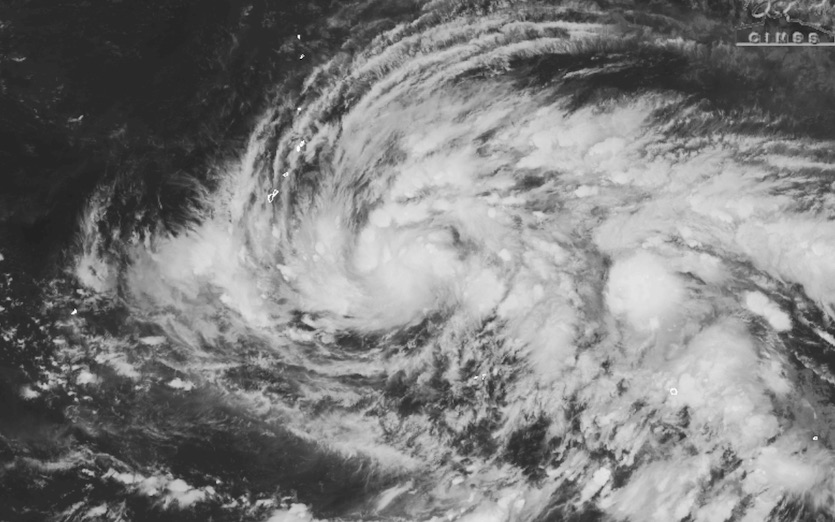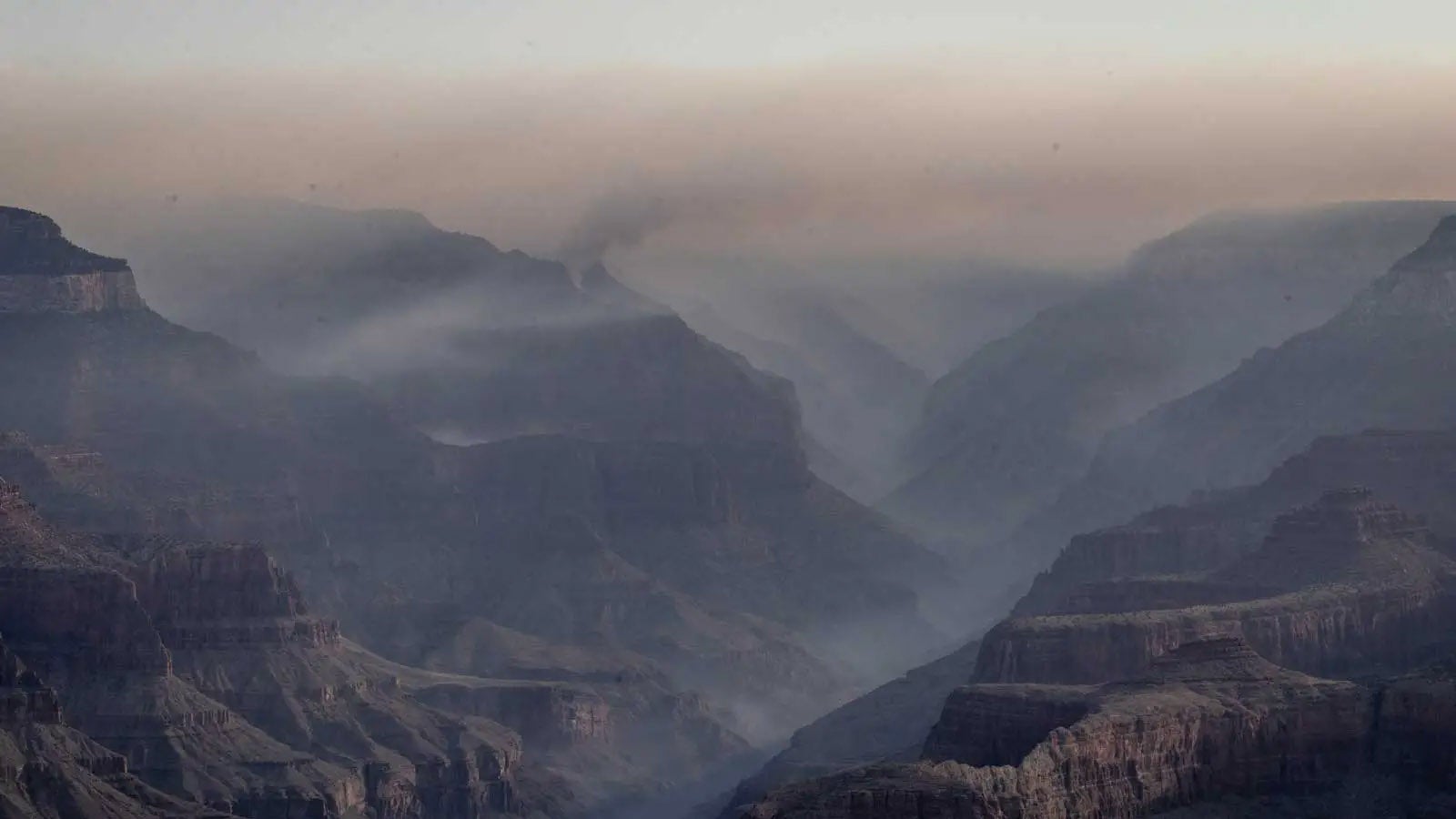| Above: A van drives along Wyoming Boulevard in Casper, Wyoming, as snow dusts Casper Mountain in the background on Monday, Nov. 25, 2019. Image credit: Cayla Nimmo/The Casper Star-Tribune via AP. |
From crippling snowfall to hurricane-force winds to torrential rain to possible tornadoes, there’s something for everyone on the U.S. weather menu this Thanksgiving week, whether it’s to their liking or not. We’re also keeping our eye on two tropics-related weather systems, one an ex-tropical storm heading into Western Europe and the other a tropical depression predicted to be a major typhoon by this weekend, perhaps threatening the Philippines next week.
A double-barrelled upper low will swing through the western U.S. in two phases over the next several days. The first major impulse—dubbed Dorothy by The Weather Channel—was diving into the Four Corners region and will swing out across the Central Plains on Tuesday and the Upper Midwest by Wednesday. North of the associated surface low, a well-defined swath of snow will extend from southern Wyoming and northern Colorado across the central plains into northern Iowa, southern Minnesota, and northwest Wisconsin. The heaviest snow is expected near the urban corridor north of Denver from Boulder, Colorado, to Cheyenne, Wyoming, where one to two feet may pile up by Tuesday afternoon. Snowfall rates of up to 2” an hour are possible Monday night. It’s quite possible that parts of Interstates 70, 80, and 25 will be closed for a time on Tuesday, and we can expect numerous delays and/or cancellations at the Denver airport.
Snow has started to fall in northern Colorado. Travel tonight through Tuesday morning is STRONGLY discouraged. For updates on this winter storm, follow the @NWSBoulder. Stay safe out there tonight, and remember we are here for you if you need us. #cowx pic.twitter.com/JEDY5nf6nA
— Wellington Fire Protection District (Colorado) (@WellingtonFire1) November 25, 2019
Another concentration of heavier snow may develop on Tuesday night and Wednesday from around Des Moines and Minneapolis into the Upper Peninsula of Michigan, with local totals of 6” to 12” possible.
Southward along the cold front, a band of heavy rain will drench pre-Thanksgiving travelers on Tuesday and Wednesday. Despite limited instability, the dynamics will be potent enough for a slight risk of severe weather—mainly high winds—in much of Missouri and Arkansas on Tuesday, according to the NOAA/NWS Storm Prediction Center.
Major windstorm aims for southwest Oregon and northwest California
As the first phase of the upper low moves into the central U.S., the second phase (named Ezekiel by The Weather Channel) will sweep onshore with a vengeance. Surface pressures could drop by as much as 30 millibars in less than 24 hours just off the coast of southwest Oregon and northwest California, more than meeting the definition of a meteorological bomb. The tight pressure gradient will produce hellacious winds—a hurricane force wind warning is in place well off the coast—and massive seas, perhaps as high as 38 feet. One to two feet of snow is expected over parts of the coastal mountains and Cascades, and snow levels could get as low as 1200 feet by Wednesday morning. Winds could even approach hurricane strength close to the coast, with gusts of 70 mph or more likely.
“This low is unprecedented in its strength and track. Storms of this magnitude have not been observed on this track in the last 15 to 20 years or more,” said the National Weather Service office in Medford, Oregon, in a forecast discussion. Based on output from multiple models, the record-low surface pressures for November in Medford, OR, and Eureka, CA (987.5 mb at both sites) are in serious jeopardy, and Medford’s all-time record-low pressure of 978 mb could even be breached.
A major winter storm is expected to impact northwest California and southwest Oregon Tuesday and Wednesday. This is not an ordinary storm! Significant impacts are expected, and weather should be factored into any holiday travel plans. #CAwx pic.twitter.com/Xs4heyWNhT
— NWS Eureka (@NWSEureka) November 25, 2019
This tight bundle of upper-level energy is projected to carve out a deep trough in the western U.S., then pull out over the Plains during the weekend and push across the Northeast by Sunday and Monday, although the timing and exact track are subject to change. Heavy snow may set up over the weekend from the northern High Plains into the western Great Lakes. There’s a more conditional threat of snow over New England on Sunday and Monday, perhaps extending into coastal areas depending on the fate of the upper low.
Meanwhile, another round of severe weather is possible over the Southern Plains by Friday. SPC has already issued a Day 5 severe outlook—unusual for November—noting the potential for all modes of severe weather, including tornadoes. Rainfall for the week could total 3-4” from parts of Oklahoma to Kentucky, much of it with this second system.
Ex-Sebastien paying a visit to Europe
Late-season Tropical Storm Sebastien was reclassified as post-tropical late Sunday night, just hours after it whipped just north of Ilha das Flores in the Azores while packing top sustained winds of 65 mph. That’s not the end of the road for this powerful storm, though. Ex-Sebastien was approaching France on Monday night as a strong extratropical storm. On its north side, several days of rain will engulf much of the United Kingdom, with flooding possible in northeast England.
There will be heavy #rain and strong winds in the southwest Tuesday morning. Cloudy with patchy rain elsewhere too pic.twitter.com/IOgUFHBMrY
— Met Office (@metoffice) November 25, 2019
Caught up in a tangle of frontal systems, Sebastien is expected to gradually strengthen on Tuesday as an upper trough catches up with it. Its central pressure may dip below 970 mb by Tuesday as it reaches Ireland. To the south of the center, wind gusts could reach 75 mph in southern England. Even stronger winds—perhaps gusting to 85 mph—may slam into northwest Spain by Tuesday night. See the forecast writeup from Severe Weather Europe for more details.
 |
| Figure 1. Infrared image of Tropical Depression 29W at 2330Z Monday, November 25, 2019. Image credit: CIMSS/SSEC/UW-Madison. |
TD 29W deserves close attention over the next week
Tropical Depression 29W could become a typhoon of concern by this weekend over the Northwest Pacific. 29W already has an extensive, well-developed circulation, with widespread pockets of convection and healthy upper-level outflow in all directions. Sea surface temperatures of around 30°C (86°F) are more than warm enough for development. As it moves west to west-northwest, 29W is likely to stay just south of the strong upper-level winds now crossing the midlatitude Pacific, allowing it to gradually gain strength. 29W is forecast by the Joint Typhoon Warning Center (JTWC) to be an intensifying tropical storm on Tuesday local time about 100-200 miles south of Guam, where a tropical storm warning is in effect. Seas up to 20 feet and squally rainbands can be expected.
TD #29W has officially formed. The system is embedded within a monsoon trough and an upper level anticyclone associated with 29W is aiding the storm's ventilation allowing there to be a crisp outflow. #Kammuri pic.twitter.com/KyYbvoxWGS
— Berry Outlooks (@BerryTracker) November 25, 2019
Later this week, as it continues chugging west, 29W will spend several days traversing a zone of very high oceanic heat content, exceeding 100 kilojoules per square centimeter. Such values are supportive of rapid intensification. The 6Z and 12Z Monday runs of the HWRF high-resolution intensity model bring 29W to typhoon strength by Wednesday local time, and they suggest that it could be a Category 4 storm by Saturday. Such strengthening appears plausible, given the very favorable ocean and atmospheric setup.
The bigger question is where 29W will move at that point. JTWC predicts with low confidence that 29W will slow to a crawl as it intensifies this weekend. Any break in the low-latitude ridge could allow 29W to recurve, but if it does not, it could head toward the Philippines by early next week, perhaps as a major typhoon.
Jeff Masters publishes his recap of the 2019 hurricane season
Category 6 founder Jeff Masters has just released his perspective-packed overview of the 2019 hurricane season. You’ll find it at his Eye of the Storm blog at ScientificAmerican.com.




